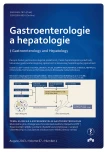Esophageal manometry
Authors:
L. Fremundová; K. Balihar; J. Koželuhová
Authors‘ workplace:
I. interní klinika FN Plzeň
Published in:
Gastroent Hepatol 2013; 67(4): 250-260
Category:
Clinical and Experimental Gastroenterology: Review Article
Overview
Esophageal manometry is a specialised diagnostic method for the examination of esophageal motility. It uses numerous pressure sensors (channels) that are evenly distributed along a thin catheter, which is inserted through the nose into the esophagus. These sensors are able to record any pressure change in the entire esophagus. This method has undergone rapid development in recent years. Now high-resolution manometry (HRM) has almost fully replaced conventional manometry, allowing us to depict the entire esophagus in detail and with high fidelity, from the upper esophageal sphincter (UES) over the esophageal body to the lower esophageal sphincter (LES). The whole esophagus, with both sphincters and peristaltic function, can be visualised concurrently. The aim of this article is to introduce HRM to our readers, to present its advantages over the conventional manometry and briefly and clearly describe how to evaluate a manometric record.
Key words:
conventional manometry – high-resolution manometry – esophagogastric junction – esophageal peristalsis
The authors declare they have no potential conflicts of interest concerning drugs, products, or services used in the study.
The Editorial Board declares that the manuscript met the ICMJE „uniform requirements“ for biomedical papers.
Submitted:
9. 1. 2013
Accepted:
10. 7. 2013
Sources
1. Crist JR. Normal values of manometry vary widely. OESO Knowledge 1991. Available from: www.hon.ch/OESO/books/Vol_4_Prim_Motility/Articles/ART025.HTML.
2. Gyawali CP. High resolution manometry: the Ray Clouse legacy. Neurogastroenterol Motil 2012; 24 (Suppl 1): 2–4.
3. Conklin J, Pimentel M, Soffer E. Color atlas of high resolution manometry. New York: Springer Science + Bussines Media, LLC 2009.
4. ASGE Technology Committee, Wang A, Pleskow DK et al. Esophageal function testing. Gastrointest Endosc 2012; 76(2): 231–243.
5. Pandolfino JE, Kwiatek MA, Nealis T et al. Achalasia: a new clinically relevant classification by high-resolution manometry. Gastroenterology 2008; 135(5): 1526–1533.
6. Pandolfino JE, Fox MR, Bredenoord AJ et al. High-resolution manometry in clinical practice: utilizing pressure topography to classify oesophageal motility abnormalities. Neurogastroenterol Motil 2009; 21(8): 796–806.
7. Pandolfino JE, Sifrim D. Evaluation of esophageal contractile propagation using esophageal pressure topography. Neurogastroenterol Motil 2012; 24 (Suppl 1): 20–26.
8. Kahrilas PJ. Esophageal motor disorders in terms of high-resolution esophageal pressure topography: what has changed? Am J Gastroenterol 2010; 105(5): 981–987.
9. Pandolfino JE, Roman S. High-resolution manometry: an atlas of esophageal motility disorders and findings of GERD using esophageal pressure topography. Thorac Surg Clin 2011; 21(4): 465–475.
10. Pandolfino JE, Roman S, Carlson D et al. Distal esophageal spasm in high-resolution esophageal pressure topography: defining clinical phenotypes. Gastroenterology 2011; 141(2): 469–475.
11. Pandolfino JE, Ghosh SK, Rise J et al. Classifying esophageal motility by pressure topography characteristic: a study of 400 patient and 75 controls. Am J Gastroenterol 2008; 103(1): 27–37.
12. Fox M. High resolution manometry – an introduction. Guy´s and St Thomas´ NHS Foundation Trust. Available from: http://www.synecticsmedical.com/pdf/102_MarkFoxManoScan.pdf.
13. Clarke JO, Gyawali CP, Tatum RP. High--resolution manometry. Ann N Y Acad Sci 2011; 1232 : 349–357.
14. Bredenoord AJ, Fox M, Kahrilas PJ et al. Chicago classification criteria of esophageal motility disorders defined in high resolution esophageal pressure topography. Neurogastroenterol Motil 2012; 24 (Suppl 1): 57–65.
15. Lin Z, Kahrilas PJ, Roman S et al. Refining the criterion for an abnormal Integrated Relaxation Pressure in esophageal pressure topography based on the pattern of esophageal contractility using a classification and regression tree model. Neurogastroenterol Motil 2012; 24(8): 356–363.
16. Rohof WO, Salvador R, Annese V et al.Outcomes of treatment for achalasia depend on manometric subtype. Gastroenterology 2013; 144(4): 718–725.
Labels
Paediatric gastroenterology Gastroenterology and hepatology SurgeryArticle was published in
Gastroenterology and Hepatology

2013 Issue 4
Most read in this issue
- Esophageal manometry
- Pentasa Sachet 2 g
- Proton pump inhibitors: side effects and interaction
- Peroral endoscopic myotomy (POEM) for the treatment of a rare type III achalasia
